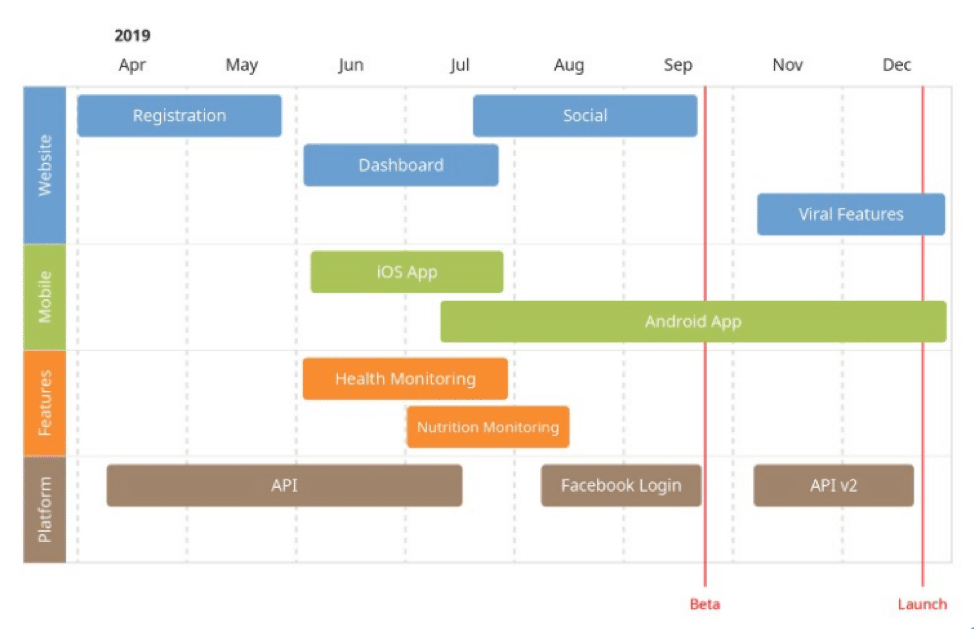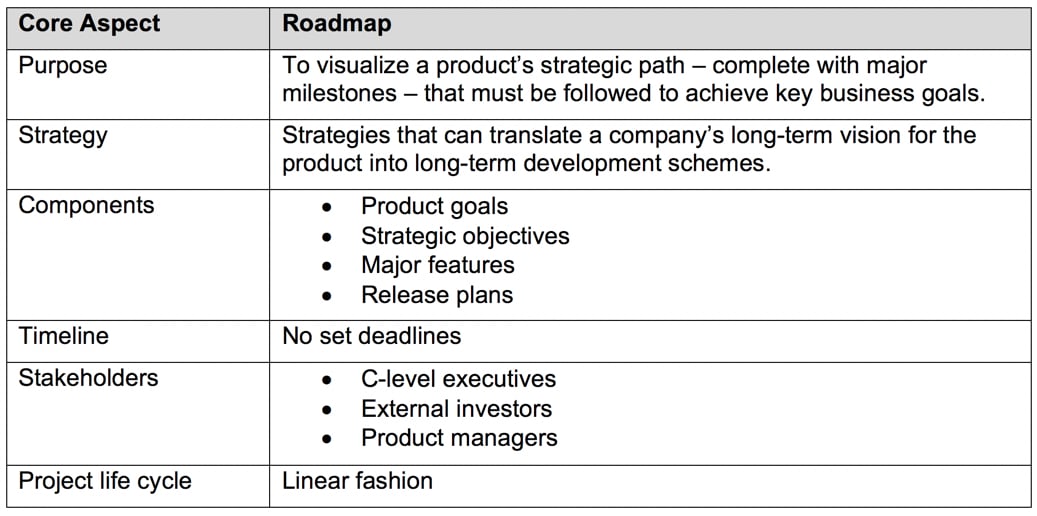A roadmap streamlines business goals into strategic and executable paths. In the context of project management, a roadmap can span across multiple timelines for continuous product development.
Why do you need a product roadmap?
A roadmap is crucial for visualizing a product’s strategy that is aligned with your business goals, while incorporating customer insights for future developments.
Think of it this way: when you’re on a road trip, you rely on a map to ensure that you’re going in the right direction without missing must-see attractions. The same goes for creating new products or services. A high-level roadmap explains the strategic course of action with major milestones that you must complete to deliver your products on time.
To understand roadmaps better, let’s look at the following hypothetical scenario.
BeHealthy Inc., a prepared-meal delivery company, is developing a personal nutrition assistant app called SmartEat. They have designed a product roadmap as below:
Components of a Roadmap
In the scenario above, the product roadmap must identify:
1. Product Goal
-
- To build a consumer-oriented nutrition recommending app that assists in monitoring what the user has eaten and what he/she needs to consume to reach a target health goal accurately and effectively.
2. Strategic Objective
-
- Ensure nutrition plan can be customized for each individual, taking into account dietary restrictions, physical condition, etc.
- Release beta version with core features on both iOS and Android
- Continuously conduct user acceptance testing to refine the user experience
3. Major Features
-
- Daily nutrition consumption monitoring
- Diet and fitness monitoring
- Individualized meal preparation menus
- Food reports with benefits and recommendations
4. Release Plans
-
- Beta version by September
- Product launch in November
Now, who do you create this roadmap for? Your most important audiences are senior management, external investors, and product managers. They are responsible for assessing the tangible business value of your product roadmap. Make sure that you communicate the final product roadmap with the rest of your team so everyone can see the picture and is on the same page.
Note that a roadmap does not have a specific deadline as compared to a timeline. The most important phase of creating a roadmap is product scoping. This is where you involve respective stakeholders to determine the goals as well as features that go into development.
How to create a product roadmap
Here’s a quick guide to creating your product roadmap.
Since the roadmap identifies all the initiatives required for the creation and marketing of a product, it involves long-term strategies to achieve important business goals. An excellent roadmap can accurately translate the company’s long-term vision for the product into long-term development schemes.
More often than not, a product roadmap is executed phase by phase in a linear fashion. What this means is that the completion of one phase will trigger the start of the next consecutive phase.
Back to the development of the hypothetical SmartEat app: Before developing the app, the company must first ensure its data policy is in place, while documenting the list of foods that should be included/excluded. Only then, can the product manager initiate the product scoping. To do this, the product manager may collaborate with the market analysis team to determine which features should be prioritized and worked on. Once the features have been finalized, the development team can jump in to prepare the mockup and choose the ideal development platform.
You can leverage any project management software to create a product roadmap; Microsoft Project, Atlassian Jira and Confluence are popular choices. I recommend that you choose software that can integrate the full development cycle, from planning and execution, to testing and improvement. The Atlassian product suite is best suited for this task. It provides a powerful tool for managing agile workflows, and allows you to track and manage user feedback and requests after product launch. What’s even better is that the Atlassian product suite can be integrated with third-party apps for seamless cross-functional collaboration.
Conclusion
Check the table below for a quick breakdown on project roadmaps:
Minju Kang is an incoming Associate Product Manager (APM) at Loblaw Digital, Canada’s largest retailer. She was formerly an Associate Product Marketing Manager (APMM) at Microsoft within Azure. She also has experience in scaling product user cases at TD Bank and Overbond (fintech).
Image: Pexels


